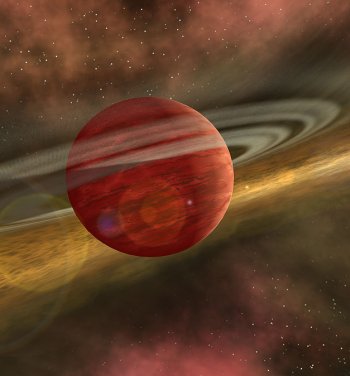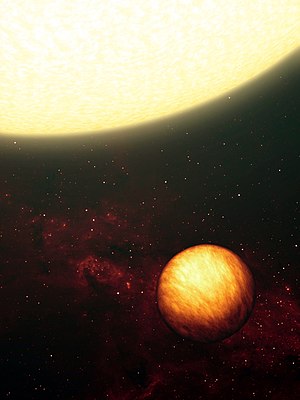The universe is so vast. Human-inhabited planet, planet Earth is one of a thousand, million, or even one of the trillions of planets scattered in space. Based on these facts, of course, you never or often assume there may be other than life on earth. The scientists believe the possibility is there and from time to time continue to look for clues to discover a new world.
In 1990, scientists found a glimmer of hope in finding a number of planets outside our solar system (Exoplanet). The planets are very diverse. Starting from the planet of fire, the giant planets, rocky planets, planets that do not have stars, and many more. Until now, the discovery of 230 planets Exoplanet reached. Here is a list of ten 2009 version Exoplanet Space.com.
1. The Fire Horse Image via Wikipedia
Image via Wikipedia
Planet 51 Pegasi b was the first Exoplanet hunters who found the planet in 1990. Planets like Jupiter, but the temperature this summer was nicknamed Bellerphon, hero of Greek myth who tamed the winged horse Pegasus. Giving a nickname based on the constellation Pegasus, the location of the planet.
2. Earth Nearest Neighbor
3. Planets Without Stars

There are a number of Exoplanet the stars or the sun has more than one, even to have three sun. Another case with Planemos. Planet is just "floating" around out without any stars.
4. agile

5. World Fire and Ice

This planet is "locked" to the star, just like the moon is always a satellite of the earth. Thus, one side of the planet Upsilon Andromeda b was always facing it. This position creates the highest temperature so far known to astronomers. One side of the planet is very hot like lava, while the other side very cold temperature
6. The Big Ring

Planets orbiting the star Tau Coku Exoplanet 4 is the youngest aged less than one million years. Astronomers detect the presence of the hole planet is greater than the planet's rings. The hole size ten times larger than Earth.
7. The Old Planet

The oldest planet also called Primeval this world was about 12.7 billion years old. The scientists suspect that planet formed eight billion years ago before the earth was only realized and two billion years of the Big Bang event. This discovery led to a discourse that life may occur earlier than expected so far.
8. Shrinking planet

Similar to the sweeps-10, HD209458b planets orbiting very close to its star that the planet's atmosphere is swept away by stellar winds. Some scientists estimate the planet is losing ten thousand tons of material every second. In the end, perhaps only the core of the planet that will remain.
9. The thick atmosphere

Planet HD 189733b is the first planetary atmospheres "smelled" by scientists. By analyzing the light from the planet's star system, astronomers say the planet's atmosphere is covered by such a thick fog similar to grains of sand. Unfortunately, the water was not detected on the planet. However, the planet hunters think there's life beyond the thick fog.
10. Earth's twin?

Could there be other life out there? The scientists say can be more revealing it in 2013, when work on high-tech telescope called the James Webb Space Telescope (JWST)

0 comments
Post a Comment